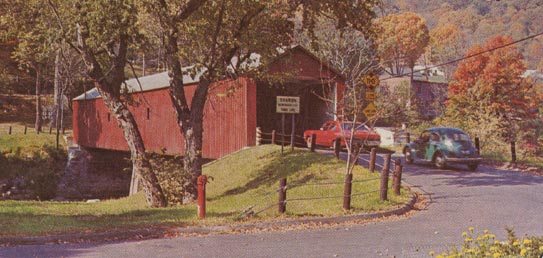In contrast to the mainframe and biotech companies along Massachusetts' Route 128, Connecticut's version offers a covered bridge and other Litchfield County scenery.
Updated Dec 3, 2024
 |
In contrast to the mainframe and biotech companies along Massachusetts' Route 128, Connecticut's version offers a covered bridge and other Litchfield County scenery.
In the 1920s, State Highway 128 followed today's US 202 from Danbury to Torrington. In 1932, that became part of Route 25.
The modern Route 128 was commissioned in 1932, taking over from the old SH 309, and hasn't changed since then. However, there was a relocation proposal; see below.
 Covered Bridge, Route 128, West Cornwall. From cover of 1974 official state highway map.
Covered Bridge, Route 128, West Cornwall. From cover of 1974 official state highway map.
The single-lane West Cornwall Bridge on Route 128 (pictured) is one of two remaining covered bridges in Connecticut open to traffic. It was constructed in 1864, on the site of an earlier bridge built in 1841.
For a short time in 1969 and 1970, the state was studying a relocation of Route 128 in the West Cornwall area. Not a freeway: even in 1969 that idea would be far-fetched. Here's what happened.
In May 1969, after a routine inspection of the West Cornwall Bridge revealed structural issues, state engineers lowered the weight limit from 10 tons to 4 tons. Trucks and school buses could no longer use the bridge and were required to detour. The state mulled removing the bridge from the state highway system and preserving it as a historical landmark. In October 1969, the DOT announced it would pursue funds for a new bridge.
In June 1970, the state unveiled 3 alternatives for a new bridge (or 2) and a relocated Route 128.
Cornwall residents were mostly strongly opposed to any bypass and preferred rehabilitating the original bridge. A few months later, in September 1970, the state and town came to an agreement. A relocated Route 128 and new bridge were off the table. Instead, the existing bridge would be rehabilitated to support 15-ton vehicles, and continue to serve as the primary connection to US 7.
In 1973 the state rehabilitated the bridge and installed a concealed steel deck to help bear traffic loads. The bridge was also raised two feet for greater protection against flood waters. This work garnered a first-place award from the Federal Highway Administration (FHWA) for preservation of a historic site.